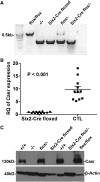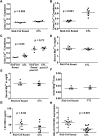Deficiency of the calcium-sensing receptor in the kidney causes parathyroid hormone-independent hypocalciuria
- PMID: 22997254
- PMCID: PMC3482734
- DOI: 10.1681/ASN.2012030323
Deficiency of the calcium-sensing receptor in the kidney causes parathyroid hormone-independent hypocalciuria
Abstract
Rare loss-of-function mutations in the calcium-sensing receptor (Casr) gene lead to decreased urinary calcium excretion in the context of parathyroid hormone (PTH)-dependent hypercalcemia, but the role of Casr in the kidney is unknown. Using animals expressing Cre recombinase driven by the Six2 promoter, we generated mice that appeared grossly normal but had undetectable levels of Casr mRNA and protein in the kidney. Baseline serum calcium, phosphorus, magnesium, and PTH levels were similar to control mice. When challenged with dietary calcium supplementation, however, these mice had significantly lower urinary calcium excretion than controls (urinary calcium to creatinine, 0.31±0.03 versus 0.63±0.14; P=0.001). Western blot analysis on whole-kidney lysates suggested an approximately four-fold increase in activated Na(+)-K(+)-2Cl(-) cotransporter (NKCC2). In addition, experimental animals exhibited significant downregulation of Claudin14, a negative regulator of paracellular cation permeability in the thick ascending limb, and small but significant upregulation of Claudin16, a positive regulator of paracellular cation permeability. Taken together, these data suggest that renal Casr regulates calcium reabsorption in the thick ascending limb, independent of any change in PTH, by increasing the lumen-positive driving force for paracellular Ca(2+) transport.
Figures







Comment in
-
Parathyroid hormone-independent role for the calcium-sensing receptor in the control of urinary calcium excretion.J Am Soc Nephrol. 2012 Nov;23(11):1766-8. doi: 10.1681/ASN.2012090955. Epub 2012 Oct 18. J Am Soc Nephrol. 2012. PMID: 23085632 No abstract available.
Similar articles
-
PTH-independent regulation of blood calcium concentration by the calcium-sensing receptor.J Clin Invest. 2012 Sep;122(9):3355-67. doi: 10.1172/JCI57407. Epub 2012 Aug 13. J Clin Invest. 2012. PMID: 22886306 Free PMC article.
-
Reduced expression of renal Na+ transporters in rats with PTH-induced hypercalcemia.Am J Physiol Renal Physiol. 2004 Mar;286(3):F534-45. doi: 10.1152/ajprenal.00044.2003. Epub 2003 Nov 18. Am J Physiol Renal Physiol. 2004. PMID: 14625199
-
New functional aspects of the extracellular calcium-sensing receptor.Curr Opin Nephrol Hypertens. 2014 Jul;23(4):352-60. doi: 10.1097/01.mnh.0000447016.21228.e0. Curr Opin Nephrol Hypertens. 2014. PMID: 24867673 Free PMC article. Review.
-
Parathyroid hormone controls paracellular Ca2+ transport in the thick ascending limb by regulating the tight-junction protein Claudin14.Proc Natl Acad Sci U S A. 2017 Apr 18;114(16):E3344-E3353. doi: 10.1073/pnas.1616733114. Epub 2017 Apr 3. Proc Natl Acad Sci U S A. 2017. PMID: 28373577 Free PMC article.
-
Thick ascending limb: the Na(+):K (+):2Cl (-) co-transporter, NKCC2, and the calcium-sensing receptor, CaSR.Pflugers Arch. 2009 May;458(1):61-76. doi: 10.1007/s00424-008-0607-1. Epub 2008 Nov 4. Pflugers Arch. 2009. PMID: 18982348 Free PMC article. Review.
Cited by
-
Autosomal Dominant Hypocalcemia (Hypoparathyroidism) Types 1 and 2.Front Physiol. 2016 Oct 18;7:458. doi: 10.3389/fphys.2016.00458. eCollection 2016. Front Physiol. 2016. PMID: 27803672 Free PMC article. Review.
-
Control of PTH secretion by the TRPC1 ion channel.JCI Insight. 2020 Apr 23;5(8):e132496. doi: 10.1172/jci.insight.132496. JCI Insight. 2020. PMID: 32213715 Free PMC article.
-
Reduced renal calcium excretion in the absence of sclerostin expression: evidence for a novel calcium-regulating bone kidney axis.J Am Soc Nephrol. 2014 Oct;25(10):2159-68. doi: 10.1681/ASN.2014020166. Epub 2014 May 29. J Am Soc Nephrol. 2014. PMID: 24876121 Free PMC article. Review.
-
Contribution of thick ascending limb and distal convoluted tubule to glucose-induced hypercalciuria in healthy controls.Am J Physiol Renal Physiol. 2023 Dec 1;325(6):F811-F816. doi: 10.1152/ajprenal.00130.2023. Epub 2023 Oct 12. Am J Physiol Renal Physiol. 2023. PMID: 37823200 Free PMC article.
-
Association study of CLDN14 variations in patients with kidney stones.Open Life Sci. 2022 Feb 28;17(1):81-92. doi: 10.1515/biol-2021-0134. eCollection 2022. Open Life Sci. 2022. PMID: 35291565 Free PMC article.
References
-
- Civitelli R, Ziambaras K: Calcium and phosphate homeostasis: Concerted interplay of new regulators. J Endocrinol Invest 34[Suppl]: 3–7, 2011 - PubMed
-
- Brown EM, Gamba G, Riccardi D, Lombardi M, Butters R, Kifor O, Sun A, Hediger MA, Lytton J, Hebert SC: Cloning and characterization of an extracellular Ca(2+)-sensing receptor from bovine parathyroid. Nature 366: 575–580, 1993 - PubMed
-
- Riccardi D, Kemp PJ: The calcium-sensing receptor beyond extracellular calcium homeostasis: Conception, development, adult physiology, and disease. Annu Rev Physiol 74: 271–297, 2012 - PubMed
-
- Brown EM, Pollak M, Riccardi D, Hebert SC: Cloning and characterization of an extracellular Ca(2+)-sensing receptor from parathyroid and kidney: New insights into the physiology and pathophysiology of calcium metabolism. Nephrol Dial Transplant 9: 1703–1706, 1994 - PubMed
-
- Brown EM, Pollak M, Hebert SC: The extracellular calcium-sensing receptor: Its role in health and disease. Annu Rev Med 49: 15–29, 1998 - PubMed
Publication types
MeSH terms
Substances
Grants and funding
LinkOut - more resources
Full Text Sources
Molecular Biology Databases
Research Materials
Miscellaneous

